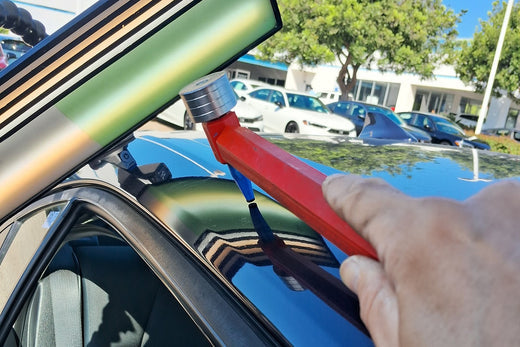
5 Tips and Techniques for Paintless Dent Repair Beginners
Share
If you’re new to Paintless Dent Repair, then this article is for you.
If you’re reading this then you should be at the stage of either determining if you should go into the field of professional paintless dent repair or already underway into training yourself. Perhaps you have acquired a practice hood and a few PDR rods and are spending time on the weekend or after your regular job making and fixing your own dents with PDR. If you’re still at the first stage that I mentioned, then the practice hood should be your next step. If you are past both of the stages that I mentioned and can learn something new here, then more power to you.
In this blog post I will not be going over “what is paintless dent repair” and if you’re wondering if you should try to fix a dent on your own car with no prior training or research, unless you really don’t care about how your car looks afterwards, then the answer is an emphatic NO.
What I will be discussing are a few tips for beginners on how to fix dents with paintless dent repair. This will be a short post discussing 5 tips for beginners, with more to come in the future.
Tip 1: Learn cross-checking with lines with you Paintless Dent Repair Light
There is kind of a divide within the paintless dent repair community on which form of LED Paintless Dent Repair light board is better; lines or fog. While fog is much more common, probably because it tends to be easier to learn, lines might be better for a few reasons (some people may strongly disagree with this.) The main reason that lines may be better is that it is easier to see some spots that you might have missed that would be covered up by a push mark when using fog. In other words, you can kind of cross-check your work without actually needing to move your PDR light to a different angle. My solution for this, and I’ve noticed a few other people doing it when watching their videos, is to place a few lines of pin-striping somewhere on your board. This way you can simply move your head to cross-check as you work without actually stopping and moving your board.

Photo: My Paintless Dent Repair light with a few lines of pin striping on the far side of the light cover
Tip 2: Don’t over-pull your glue pulls
Using hot glue while doing paintless dent repair is amazing but it can be frustrating at times. It allows us to fix dents on areas that would otherwise be unrepairable because we cannot get a PDR rod behind the panel. It also allows us to fix some dents or dings much quicker because we don’t need to remove trim pieces to access an area on the car.
Sometimes, however, the glue stick that we’re using fuses much too hard to the panel and is still stuck even after we moved the amount of metal that we wanted to with a glue pull. Most paintless dent repair technicians will spray the glue tab and then do another glue pull with their mini lifter to get the tab off, or pull the tab at an angle until it comes off. This tends to move the metal even more, resulting in a high spot that will need to be tapped down.
I made a tool to fix this frustrating step from needing to occur, called the Razor Scraper for Plastic Blades. After you have pulled the glue tab as much as you needed to and spray the glue tab, you stick this tool between the glue and tab and tap on the end with your PDR hammer. It has definitely reduced the amount of knocking down after my glue pulls.

Above: Our Razor Scraper for Plastic Blades a PDR tool used to separate a glue tab from a truck door panel.
Tip 3: Take a break
When working on a dent we generally work until the job is completed then pack up for the day. It is usually in our best interest to skip breaks and get the job done as quickly as possible. Sometimes, though, especially on difficult damage, we get so wrapped up in the repair that we might miss some things, like a high spot that conceals our view of a low. That is why it is always a good idea to take a break if you feel that you are stuck on a repair. Even the act of walking towards the dent and seeing it from a distance might make you notice some things that you overlooked when you were closer to the damage.
Tip 4: Learn the basics of blending in paintless dent repair
Blending is an incredibly useful skill that many PDR techs, myself included until not too long ago, have a difficult time performing. The payoff once you do get the hang of it is immense. Blending a small ding instead of glue pulling then knocking down can be much faster in some instances. Finishing your repairs becomes much faster since you can use your blending hammer to knock down many of the ripples that make your repair look ugly.
Many manufacturers have blending hammers and none in my opinion really stand out among the many. Carbon Tech, Keco, and Cam Auto all have their own versions of blending hammers. I made one at 3DPaintless.com that really helped me learn the basics of blending. It is called the Blending/Finishing Hammer Tilted Head. Unlike other PDR blending hammers the head is tilted, allowing you to rest your wrist on the panel while using it to blend out a dent. This gave me more stability and control while blending, and helped me learn a skill that I had wanted to for so long.

Above: Using a PDR Blending Hammer sold by 3DPaintless.com
Tip 5: Learn to work with your non-dominant hand
This one is pretty obvious and really only applies to people at the very beginning of their career, but if you recall from the introduction, this PDR article is written with them in mind. I will write another blog post in the near future with some tips for people that have been performing paintless dent repair for a while. Working with your non-dominant hand is completely unavoidable since we need to access the dent from all sorts of strange positions and angles. If you are still early into your training, then it is probably best to start getting a feel for repairing a dent with your left hand (or your right hand if you’re a lefty.) If strength with your non-dominant hand is an issue, then I’ve found that lifting weights tends to even out the strength in your arms much more than if you don’t strength train. A benefit of practicing early with your non-dominant hand is you can catch this weakness early and take measures to correct it.
Applying these PDR tips and techniques in the field
We’ve gone over some tips and techniques that you might not have learned, or potentially ignored up to this point in your paintless dent removal career. Hopefully you will take some of these techniques and apply them when fixing dings and dents on cars in the future. If this post gets some positive feedback then I will try to write more in the future. Please take a moment to check out some of the Paintless Dent Repair tools that I’ve made at 3DPaintless.com. It would mean a lot to me.

